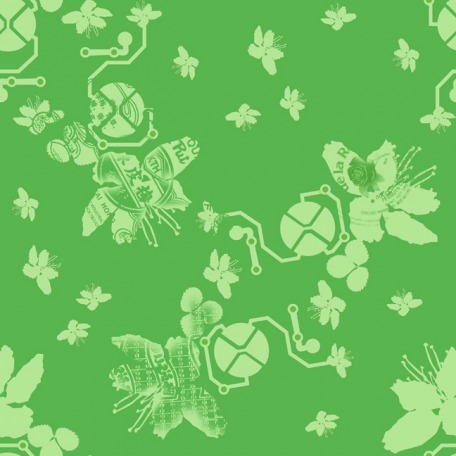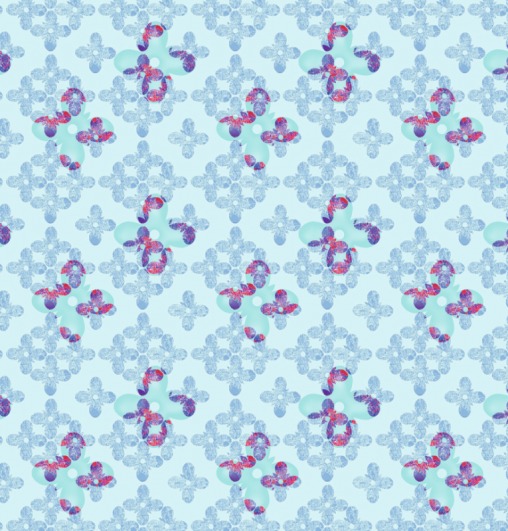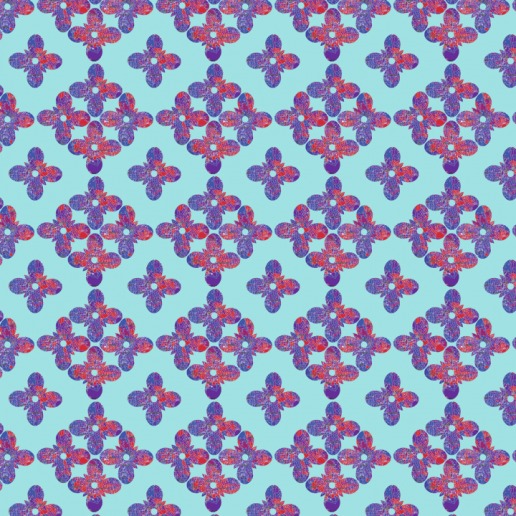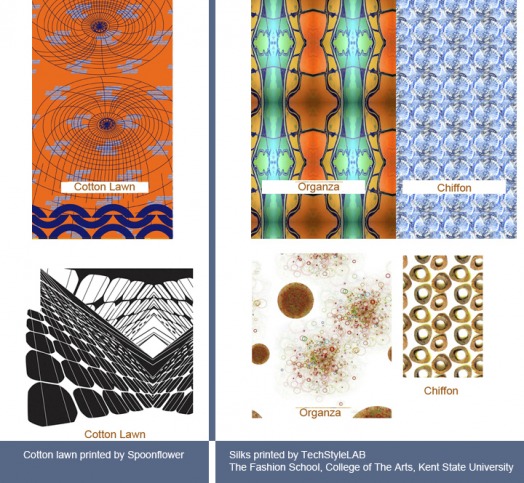I created this video below to show some of the initial process of my collaboration with Colleen Quen, Rick Lee and the San Jose Museum of Quilts & Textiles.
Cultural Tech-Fusion Fabrics
I just ordered some yardage of secondary fabrics for the fusionwear sv project. I revisited a few of the designs to add texture and a bit more meaning. Below I added Japanese, Chinese and Mexican food wrappers to the motif to reference these cultures that contributed greatly to agriculture here in Santa Clara.
Below is a revised piece referencing demographics. I wanted to tone down the color palette to match the Japanese porcelain bowl textile better. I add a bit more subtly to it. Below this new design is the original pattern.
I have always envisioned my exploration into cultural textiles to include students I teach in Alum Rock.
What do I want my students to learn?
1. Students will learn that they each have a valuable personal visual vocabulary which grows and enriches just as their verbal vocabulary does.
2. Students will begin to recognize and express that vocabulary in their art and writing.
3. Students will connect and truly examine the intimate community of their neighborhoods and see how that intimate community visual vocabulary is part of a larger visual vocabulary in a larger community. Students will learn to curate an art show and articulate the meaning of the patterns they created.
Rather than be passive consumers of culture, I hope through this project students will begin to develop the tools to be active creators of culture.
What will they do?
Students will represent Alum Rock in pattern and print through creation of digital textiles. This is exploration into visual metaphor, culture and geometry.
I envision using this Basso & Brooke research trip video as one of the leads to the project.
1. Students will explore their community and document in photographs.
2. They will upload, Geotag and describe how the image represents their community. This will anchor their images to the point on the map they were taken so other could take an online visual tour and learn about their community. This map will be accessible through a project website, a portal for an authentic audience.
3. Working in teams of three, students will collaborate in selecting images they think distill their community the best and then they will collaborate in designing a textile pattern (could be created from photos in SumoPaint or freehand sketches which I would convert to Illustrator files). The resulting patterns will be printed as digital textiles.
4. The students will collaborate in designing a textile sculptural installation. They will learn about converting flat design into a 3-D (pattern drafting) and they will stitch together the final creation.
5. Student would each write an artist statement to accompany their design. This statement would be incorporated into an ISSUU catalog and into signage for museum setting.
6. Dream for the project: Project results in student curated show installation in KCI Art Gallery. Students attend a reception for show at the KCI Gallery. A student reception would not only honor the completion of the project, but would create a moment in time where students feel they belong at a college and that a college experience is part of their future.
How will you know they have learned it?
We will have a Google document survey at the beginning of the project asking them what does "vocabulary" mean, what does "metaphor" mean, and what does "community" mean? and a Google peer review poll throughout the project and final written evaluation of project. Students will document process of project in project website blog.
How can I design this project to be scalable?
Physical banners and bus shelters in Alum Rock.
A textile pattern activity kit created by students and posted on the project website for other students at other schools to replicate a similar project.
Make this a cross school collaborative project by coordinating with a school in another State.
I also am mining great information from The Victoria & Albert Museum in London regarding educational textile activities. Here are a few particular activities I found relevant: Mirror image design and Repeat Patterns.
What do I want my students to learn?
1. Students will learn that they each have a valuable personal visual vocabulary which grows and enriches just as their verbal vocabulary does.
2. Students will begin to recognize and express that vocabulary in their art and writing.
3. Students will connect and truly examine the intimate community of their neighborhoods and see how that intimate community visual vocabulary is part of a larger visual vocabulary in a larger community. Students will learn to curate an art show and articulate the meaning of the patterns they created.
Rather than be passive consumers of culture, I hope through this project students will begin to develop the tools to be active creators of culture.
What will they do?
Students will represent Alum Rock in pattern and print through creation of digital textiles. This is exploration into visual metaphor, culture and geometry.
I envision using this Basso & Brooke research trip video as one of the leads to the project.
1. Students will explore their community and document in photographs.
2. They will upload, Geotag and describe how the image represents their community. This will anchor their images to the point on the map they were taken so other could take an online visual tour and learn about their community. This map will be accessible through a project website, a portal for an authentic audience.
3. Working in teams of three, students will collaborate in selecting images they think distill their community the best and then they will collaborate in designing a textile pattern (could be created from photos in SumoPaint or freehand sketches which I would convert to Illustrator files). The resulting patterns will be printed as digital textiles.
4. The students will collaborate in designing a textile sculptural installation. They will learn about converting flat design into a 3-D (pattern drafting) and they will stitch together the final creation.
5. Student would each write an artist statement to accompany their design. This statement would be incorporated into an ISSUU catalog and into signage for museum setting.
6. Dream for the project: Project results in student curated show installation in KCI Art Gallery. Students attend a reception for show at the KCI Gallery. A student reception would not only honor the completion of the project, but would create a moment in time where students feel they belong at a college and that a college experience is part of their future.
How will you know they have learned it?
We will have a Google document survey at the beginning of the project asking them what does "vocabulary" mean, what does "metaphor" mean, and what does "community" mean? and a Google peer review poll throughout the project and final written evaluation of project. Students will document process of project in project website blog.
How can I design this project to be scalable?
Physical banners and bus shelters in Alum Rock.
A textile pattern activity kit created by students and posted on the project website for other students at other schools to replicate a similar project.
Make this a cross school collaborative project by coordinating with a school in another State.
I also am mining great information from The Victoria & Albert Museum in London regarding educational textile activities. Here are a few particular activities I found relevant: Mirror image design and Repeat Patterns.
Today I drove the swatches I received from Spoonflower up to Colleen Quen. In reviewing the fabrics this is how Colleen wishes to order them. The two left images will be on cotton lawn from Spoonflower (I just put in the order for 10 yards of each). The other four designs will be ordered from TechStyleLAB at Kent State University.



